

A ceRNA Hypothesis: The Rosetta Stone of a Hidden RNA Language? To view the full text, please login as a subscribed user or purchase a subscription.

Click here to view the full text on ScienceDirect. Here, we present a unifying hypothesis about how messenger RNAs, transcribed pseudogenes, and long noncoding RNAs “talk” to each other using microRNA response elements (MREs) as letters of a new language. We propose that this “competing endogenous RNA” (ceRNA) activity forms a large-scale regulatory network across the transcriptome, greatly expanding the functional genetic information in the human genome and playing important roles in pathological conditions, such as cancer. Register an Account If you do not have an account, create one by clicking the button below, and take full advantage of this site's features. An HNF4α-miRNA Inflammatory Feedback Circuit Regulates Hepatocellular Oncogenesis. Cancer Cell - Polycomb Regulates NF-κB Signaling in Cancer through miRNA. Dual Regulation of miRNA Biogenesis Generates Target Specificity in Neurotrophin-Induced Protein Synthesis.
Figure S1 Composition of Neuronal P Bodies, Related to Figure 1 (A) Endogenous Dcp1a (top, red) colocalizes with GFP-Dcp1a (middle, green) in a confocal projection of hippocampal pyramidal neuron dendrites.

(Bottom) Overlaid image. (B) mCherry-tagged Dcp1a (top, red) colocalizes with GFP-tagged Ago2 (middle, green) in a confocal projection. (Bottom) Overlaid image. (C) Endogenous Rck/p54 (top, red) colocalizes with endogenous GW182 (middle, green) in a confocal projection. Elsevier introduces Genome Viewer. 3′ End Formation of PIWI-Interacting RNAs In Vitro. To view the full text, please login as a subscribed user or purchase a subscription.

Click here to view the full text on ScienceDirect. Figure 1 Siwi, but Not BmAgo3, Preferentially Incorporates 1U RNA In Vitro (A and B) 26 nt or 50 nt 5′-radiolabeled RNAs with 5′ U, A, G, or C were incubated in 17,000 × g lysate from BmN4 cells expressing FLAG-Siwi (A) or FLAG-BmAgo3 (B), and the associated RNAs were immunopurified by anti-FLAG antibody. Input samples were diluted >500 fold. Figure 2. 3′ End Formation of PIWI-Interacting RNAs In Vitro.
A Critical Role for Noncoding 5S rRNA in Regulating Mdmx Stability. To view the full text, please login as a subscribed user or purchase a subscription.
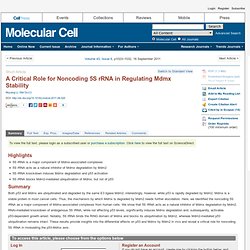
Click here to view the full text on ScienceDirect. Figure 1 5S rRNA Directly Interacts with Mdmx Both In Vitro and In Vivo. A Date with Telomerase: Pick You Up at S Phase. A Pre-mRNA Degradation Pathway that Selectively Targets Intron-Containing Genes Requires the Nuclear Poly(A)-Binding Protein. To view the full text, please login as a subscribed user or purchase a subscription.

Click here to view the full text on ScienceDirect. Figure 1. A Primate Herpesvirus Uses the Integrator Complex to Generate Viral MicroRNAs. To view the full text, please login as a subscribed user or purchase a subscription.
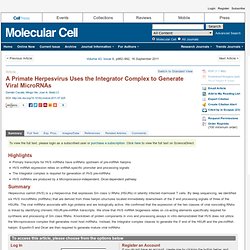
Click here to view the full text on ScienceDirect. Figure 1 HVS miRNAs Are Located Directly Downstream of HSUR Genes. A Specific Function for the Histone Chaperone NASP to Fine-Tune a Reservoir of Soluble H3-H4 in the Histone Supply Chain. To view the full text, please login as a subscribed user or purchase a subscription.
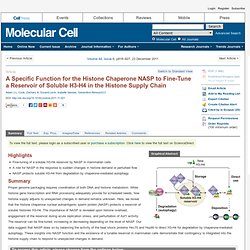
Click here to view the full text on ScienceDirect. A Universal RNA Polymerase II CTD Cycle Is Orchestrated by Complex Interplays between Kinase, Phosphatase, and Isomerase Enzymes along Genes. To view the full text, please login as a subscribed user or purchase a subscription.
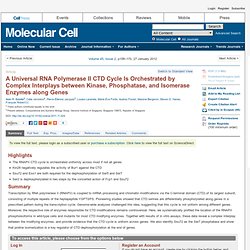
Click here to view the full text on ScienceDirect. Figure 1 A Uniform CTD Cycle at Most Transcribed Genes. A Universal RNA Polymerase II CTD Cycle Is Orchestrated by Complex Interplays between Kinase, Phosphatase, and Isomerase Enzymes along Genes. Acetylation Regulates the Stability of a Bacterial Protein: Growth Stage-Dependent Modification of RNase R. To view the full text, please login as a subscribed user or purchase a subscription.

Click here to view the full text on ScienceDirect. Alternative miRNA Biogenesis Pathways and the Interpretation of Core miRNA Pathway Mutants. To view the full text, please login as a subscribed user or purchase a subscription.
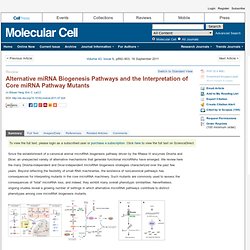
Click here to view the full text on ScienceDirect. Since the establishment of a canonical animal microRNA biogenesis pathway driven by the RNase III enzymes Drosha and Dicer, an unexpected variety of alternative mechanisms that generate functional microRNAs have emerged. We review here the many Drosha-independent and Dicer-independent microRNA biogenesis strategies characterized over the past few years. Beyond reflecting the flexibility of small RNA machineries, the existence of noncanonical pathways has consequences for interpreting mutants in the core microRNA machinery.
Such mutants are commonly used to assess the consequences of “total” microRNA loss, and indeed, they exhibit many overall phenotypic similarities. Register an Account. Alternative Ubiquitin Activation/Conjugation Cascades Interact with N-End Rule Ubiquitin Ligases to Control Degradation of RGS Proteins. To view the full text, please login as a subscribed user or purchase a subscription. Click here to view the full text on ScienceDirect.
Figure 1 Identification of UBR1, UBR2, and UBR3 as Targets of the USE1 Ubiquitin conjugating Enzyme. An RNA Reset Button. Angiogenin-Induced tRNA Fragments Inhibit Translation Initiation. Figure 5. Another “Loophole” in miRNA Processing. Applied Force Provides Insight into Transcriptional Pausing and Its Modulation by Transcription Factor NusA. To view the full text, please login as a subscribed user or purchase a subscription. Click here to view the full text on ScienceDirect. Ars2 Promotes Proper Replication-Dependent Histone mRNA 3′ End Formation. Figure 1 Ars2 Regulates a Subset of microRNAs (A) HeLa cells were transfected with control siRNA or three siRNAs targeted to either Ars2 (Ars2-1, Ars2-2, Ars2-3) or DGCR8 (DGCR8-1, DGCR8-2, DGCR8-3). Protein was harvested 3 days following transfection to confirm specific depletion of Ars2 or DGCR8 by western blot.
Autoantigen La Promotes Efficient RNAi, Antiviral Response, and Transposon Silencing by Facilitating Multiple-Turnover RISC Catalysis. Cell Adhesion-Dependent Control of MicroRNA Decay. This article has been retracted: please see Elsevier Policy on Article Withdrawal ( Competing for the Clamp: Promoting RNA Polymerase Processivity and Managing the Transition from Initiation to Elongation. Conservation between the RNA Polymerase I, II, and III Transcription Initiation Machineries. Cross-Regulation between an Alternative Splicing Activator and a Transcription Repressor Controls Neurogenesis. Decapping of Long Noncoding RNAs Regulates Inducible Genes.
Decapping of Long Noncoding RNAs Regulates Inducible Genes. Deciphering 3′ss Selection in the Yeast Genome Reveals an RNA Thermosensor that Mediates Alternative Splicing. Deciphering 3′ss Selection in the Yeast Genome Reveals an RNA Thermosensor that Mediates Alternative Splicing. Direct Regulation of tRNA and 5S rRNA Gene Transcription by Polo-like Kinase 1. Dual Function of Sdh3 in the Respiratory Chain and TIM22 Protein Translocase of the Mitochondrial Inner Membrane.
Dynamic Protein-Protein Interaction Wiring of the Human Spliceosome. Engineering Biological Systems with Synthetic RNA Molecules. Essential Features and Rational Design of CRISPR RNAs that Function with the Cas RAMP Module Complex to Cleave RNAs. Essential Features and Rational Design of CRISPR RNAs that Function with the Cas RAMP Module Complex to Cleave RNAs. Functional Association of Gdown1 with RNA Polymerase II Poised on Human Genes. Functional Expansion of the tRNA World under Stress. Genomic Maps of Long Noncoding RNA Occupancy Reveal Principles of RNA-Chromatin Interactions. Get Back TFIIF, Don't Let Me Gdown1. Gimme Phospho-Serine Five! Capping Enzyme Guanylyltransferase Recognition of the RNA Polymerase II CTD. GW182 Proteins Directly Recruit Cytoplasmic Deadenylase Complexes to miRNA Targets. Heterotypic piRNA Ping-Pong Requires Qin, a Protein with Both E3 Ligase and Tudor Domains. Heterotypic piRNA Ping-Pong Requires Qin, a Protein with Both E3 Ligase and Tudor Domains.
Immobilization of Proteins in the Nucleolus by Ribosomal Intergenic Spacer Noncoding RNA. Immobilization of Proteins in the Nucleolus by Ribosomal Intergenic Spacer Noncoding RNA. Integrative Regulatory Mapping Indicates that the RNA-Binding Protein HuR Couples Pre-mRNA Processing and mRNA Stability. Interaction Profiling Identifies the Human Nuclear Exosome Targeting Complex.
Intragenic Enhancers Act as Alternative Promoters. In Vivo and Transcriptome-wide Identification of RNA Binding Protein Target Sites. Live Cell Imaging of Telomerase RNA Dynamics Reveals Cell Cycle-Dependent Clustering of Telomerase at Elongating Telomeres. MCPIP1 Ribonuclease Antagonizes Dicer and Terminates MicroRNA Biogenesis through Precursor MicroRNA Degradation. Mediator Complex Regulates Alternative mRNA Processing via the MED23 Subunit. MicroRNA Destabilization Enables Dynamic Regulation of the miR-16 Family in Response to Cell-Cycle Changes. Molecular Mechanisms of Long Noncoding RNAs. Policing Cells under Stress: Noncoding RNAs Capture Proteins in Nucleolar Detention Centers. Policing Cells under Stress: Noncoding RNAs Capture Proteins in Nucleolar Detention Centers. Polycomb Protein Ezh1 Promotes RNA Polymerase II Elongation. R We There Yet? R-Loop Hazards to Finishing the Journey. RAM/Fam103a1 Is Required for mRNA Cap Methylation. Reconsidering Movement of Eukaryotic mRNAs between Polysomes and P Bodies.
Regional Specialization: The NEXT Big Thing in Nuclear RNA Turnover. Regulation by Small RNAs in Bacteria: Expanding Frontiers. Regulatory RNA: The New Age. RNA Homeostasis Governed by Cell Type-Specific and Branched Feedback Loops Acting on NMD. RNA Homeostasis Governed by Cell Type-Specific and Branched Feedback Loops Acting on NMD. RNA-Binding Protein HuD Controls Insulin Translation. RNase H and Multiple RNA Biogenesis Factors Cooperate to Prevent RNA:DNA Hybrids from Generating Genome Instability. RNase H and Postreplication Repair Protect Cells from Ribonucleotides Incorporated in DNA.
rRNA Pseudouridylation Defects Affect Ribosomal Ligand Binding and Translational Fidelity from Yeast to Human Cells. SAGA and ATAC Histone Acetyl Transferase Complexes Regulate Distinct Sets of Genes and ATAC Defines a Class of p300-Independent Enhancers. Scd6 Targets eIF4G to Repress Translation: RGG Motif Proteins as a Class of eIF4G-Binding Proteins. Ser7 Phosphorylation of the CTD Recruits the RPAP2 Ser5 Phosphatase to snRNA Genes. Single-Cell Analysis Reveals that Noncoding RNAs Contribute to Clonal Heterogeneity by Modulating Transcription Factor Recruitment. Structure and Mechanism of the CMR Complex for CRISPR-Mediated Antiviral Immunity.
Sub1 and RPA Associate with RNA Polymerase II at Different Stages of Transcription. SUMO-Specific Protease 1 Is Critical for Early Lymphoid Development through Regulation of STAT5 Activation. The cAMP-Dependent Protein Kinase Signaling Pathway Is a Key Regulator of P Body Foci Formation. The DEAD-Box Protein Ded1 Modulates Translation by the Formation and Resolution of an eIF4F-mRNA Complex.
The Ewing Sarcoma Protein Regulates DNA Damage-Induced Alternative Splicing. The Initiation Factor TFE and the Elongation Factor Spt4/5 Compete for the RNAP Clamp during Transcription Initiation and Elongation. The Little Elongation Complex Regulates Small Nuclear RNA Transcription. The Mediator Couples Transcription and Splicing. The Noncoding RNA Mistral Activates Hoxa6 and Hoxa7 Expression and Stem Cell Differentiation by Recruiting MLL1 to Chromatin.
The Polycomb Group Mutant esc Leads to Augmented Levels of Paused Pol II in the Drosophila Embryo. The Structural Basis for Substrate Recognition by Mammalian Polynucleotide Kinase 3′ Phosphatase. The β Subunit Gate Loop Is Required for RNA Polymerase Modification by RfaH and NusG. Transcriptional Regulation by Pol II(G) Involving Mediator and Competitive Interactions of Gdown1 and TFIIF with Pol II. Transcriptome-wide Analysis of Regulatory Interactions of the RNA-Binding Protein HuR. UneCLIPsing HuR Nuclear Function. Mutation of a U2 snRNA Gene Causes Global Disruption of Alternative Splicing and Neurodegeneration. Mutation of a U2 snRNA Gene Causes Global Disruption of Alternative Splicing and Neurodegeneration. Mutually Exclusive Binding of Telomerase RNA and DNA by Ku Alters Telomerase Recruitment Model.
Reports - faq. RNA Dynamics in Aging Bacterial Spores. Single-Molecule Imaging of Transcriptionally Coupled and Uncoupled Splicing. Structural Basis for Promoter −10 Element Recognition by the Bacterial RNA Polymerase σ Subunit. Structural Insights into RNA Recognition by RIG-I. The Human Mitochondrial Transcriptome.